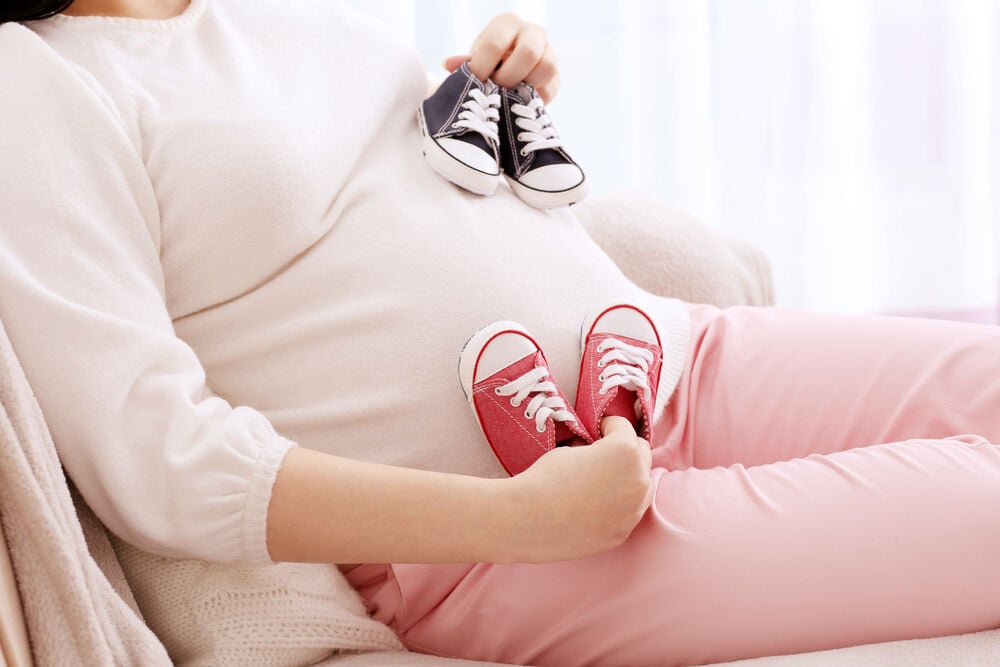Depending on whether they are monozygotic or dizygotic, twins have different defining characteristics, both in the womb and in life. Read on to learn what differentiates monozygotic twins from dizygotic ones.
-
Tracking cycle
-
Getting pregnant
-
Pregnancy
-
Help Center
-
Flo for Partners
-
Anonymous Mode
-
Flo app reviews
-
Flo Premium New
-
Secret Chats New
-
Symptom Checker New
-
Your cycle
-
Health 360°
-
Getting pregnant
-
Pregnancy
-
Being a mom
-
LGBTQ+
-
Quizzes
-
Ovulation calculator
-
hCG calculator
-
Pregnancy test calculator
-
Menstrual cycle calculator
-
Period calculator
-
Implantation calculator
-
Pregnancy weeks to months calculator
-
Pregnancy due date calculator
-
IVF and FET due date calculator
-
Due date calculator by ultrasound
-
Medical Affairs
-
Science & Research
-
Pass It On Project New
-
Privacy Portal
-
Press Center
-
Flo Accuracy
-
Careers
-
Contact Us
Monozygotic vs Dizygotic Twins: What’s the Difference?


Every piece of content at Flo Health adheres to the highest editorial standards for language, style, and medical accuracy. To learn what we do to deliver the best health and lifestyle insights to you, check out our content review principles.
How monozygotic twins form
Monozygotic twins, also known as identical twins, develop from one egg fertilized by one sperm. The frequency of monozygotic twins is around 1 in 250 pregnancies without assisted fertility.
Identical twins begin as a single egg that has been fertilized by a single sperm. From that beginning, the egg will split into two. Depending on how early the split happens, monozygotic twins may or may not share the same placenta (monochorionic) and same amniotic sac (monoamniotic).
If the egg splits between days 0 and 3, the twins will have separate placentas (dichorionic) and amniotic sacs (diamniotic).
If the egg splits between days 4 and 8, the twins will share the same placenta and have separate amniotic sacs.
If the egg splits between days 9 and 12, the twins will share the same placenta and amniotic sac.
If the egg splits after 13 days, the twins will be conjoined.
Identical twins are always the same sex and have a lot of the same DNA. However, this does not mean they are exactly the same. They may not look exactly alike and will develop into individuals with differing tastes and experiences.
Although monozygotic twins often share a special bond, experts and parents of twins feel that it is important to raise twins with an awareness of their individuality. For example, you can celebrate birthdays with individual birthday cakes. Identical twins should also be allowed to dress differently from one another if they want to. Parents of twins should also consider pointing out what makes each twin unique.
Monozygotic twins, also known as identical twins, develop from one egg fertilized by one sperm. The frequency of monozygotic twins is around 1 in 250 pregnancies without assisted fertility.
It is important to keep in mind that twins may learn differently and vary widely in their skills, strengths, and weaknesses. For this reason, some advise putting identical twins in different classes at school. Doing so can help in a number of ways. First, because twins can sometimes develop an imbalanced relationship, where one is dominant and the other submissive, being in different classes can help restore that balance. The competitiveness and comparison between twins, which can often disrupt learning, are also alleviated by placement in separate classrooms. Finally, given that twins often socialize so much together and can end up dependent on each other, learning in different classrooms gives them the opportunity to socialize with and depend on others.
Parents of monozygotic twins should remember that raising twins as individuals, as opposed to a single unit, will never detract from or harm the unique and special bond they share.
Take a quiz
Find out what you can do with our Health Assistant
How dizygotic twins form
Dizygotic, or fraternal, twins, are formed differently from monozygotic twins. Instead of a single egg, dizygotic twins begin when two separate eggs that have released simultaneously from an ovary are fertilized by two different sperm. Each zygote develops in its own sac and has its own placenta. The birth rate of dizygotic twins varies around the world. Around 1 in 1,000 pregnancies result in dizygotic twins in Japan, and around 1 in 20 pregnancies produce twins in some African countries.
Unlike monozygotic twins, each dizygotic twin always grows inside its own amniotic fluid-filled inner sac, and each develops its own placenta. However, if the zygotes are close to each other in the uterus, the two placentas may sometimes appear as one on an ultrasound.
Instead of a single egg, dizygotic twins begin when two separate eggs that have released simultaneously from an ovary are fertilized by two different sperm.
Because of these distinct differences in development, dizygotic twins will not share the same genetic material and are not identical. Most will share the same number of genes as any two siblings. Also, unlike monozygotic twins, dizygotic twins can be different sexes. In some rare instances, dizygotic twins can have different fathers. This happens when one egg is fertilized by sperm from one father, while the second egg is fertilized by sperm from another father.
What causes monozygotic and dizygotic twins to occur?

While many of the reasons behind the development of monozygotic twins remain a mystery, some insight from the process of in-vitro fertilization (IVF) may provide a clue. The reasons for dizygotic twins, on the other hand, are more well-known.
Although there are some populations where monozygotic twins are born more frequently, they are rare. To date, there has not been a gene identified with an increased chance of conceiving monozygotic twins.
However, because monozygotic twins are more common in IVF pregnancies, some research has shed light on the process that leads to the formation of identical twins. The solution the embryo lives in before implantation may contribute to the differences. The process of transferring the embryo from the solution to the uterus may also play a role.
Chances of conceiving fraternal twins from fertility drugs range from 5 percent to 30 percent, depending on the type of drug taken. IVF and intrauterine insemination treatments, for instance, account for nearly a third of all twins born in the United States.
To better understand why there is an increase in identical twins when using IVF, researchers used cameras to capture embryonic development in two-minute intervals. They observed the initial, routine stages of embryonic development, in which a fluid-filled cavity (blastocoel), grows inside the embryo. The embryo also contains the cells that develop into the fetus (the inner cell mass). In some cases, the blastocoel would then collapse on itself. But, in the case of monozygotic twins, the embryo would survive this collapse. This would cause the inner cell mass to split into two, which in turn would lead to the development of identical twins. Still, despite this insight, researchers cannot say that this represents the exact process of identical twin formation.
Even though the process of monozygotic twinning is largely inexplicable, there are a number of known causes for dizygotic twins. Fertility drugs are one common cause. Chances of conceiving fraternal twins from fertility drugs range from 5 percent to 30 percent, depending on the type of drug taken. IVF and intrauterine insemination treatments, for instance, account for nearly a third of all twins born in the United States.
In addition to fertility drugs, chances of conceiving fraternal twins are higher among women who are overweight or have fraternal twins already in their family. Ethnicity and even location play a role in twinning frequency. Women of African ethnicity are the most likely to give birth to dizygotic twins, followed by Europeans and Asian women (who are the least likely). Black Americans have the highest rates of fraternal twins in America, at around 17 per 1,000 pregnancies. The twin birth rate for Caucasian Americans is slightly lower: around 16 every 1,000 pregnancies. The highest rates for twinning can be found in Nigeria, where nearly 50 out of every 1,000 pregnancies result in dizygotic twins. These rates differ depending on the region of the country.
Monozygotic vs dizygotic twins: the key differences
Here are the key differences between monozygotic and dizygotic twins:
- Monozygotic twins are formed by one sperm and one egg. Dizygotic twins are formed by two different sperm and two different eggs.
- The reason monozygotic twins form is largely unknown, while a number of known reasons exist for dizygotic twinning.
- There is no hereditary trait that makes monozygotic twins more likely. Dizygotic twins, on the other hand, can be caused by a gene that predisposes women to hyperovulate, or release two or more eggs at one time.
- Pregnancy procedures such as IVF increase the chances of conceiving twins by 30 to 50 percent, either monozygotic or dizygotic.
How do you know whether you have monozygotic or dizygotic twins?
Determining whether you have monozygotic or dizygotic twins without a DNA test may be a challenge. During pregnancy, it’s possible that an ultrasound will reveal some telltale signs of monozygotic twins, such as a shared placenta. But ultrasounds may also be unable to pick up these differences.
There are some ways to tell whether you have monozygotic or dizygotic twins without a test. A single placenta means the twins are likely monozygotic, and if they are monoamniotic (share the same amniotic fluid), they are definitely monozygotic. If they aren’t the same sex, they are dizygotic. If they have different blood types, they are probably dizygotic as well. Of course, a DNA test can reveal all. Shared genetic markers definitely mean the twins are monozygotic, while distinct genetic markers mean the twins are dizygotic.
The takeaway
Monozygotic and dizygotic twins share some similarities but are largely different. From conception to birth and beyond, twins can share a special and uncommon bond. At the same time, all twins are individuals, informed by their environments, life experiences, and epigenetic differences. Regardless of the challenges that come with mothering twins, the many rewards more than compensate, from choosing a special set of names to learning their similarities and differences.


Hey, I'm Anique
I started using Flo app to track my period and ovulation because we wanted to have a baby.


The Flo app helped me learn about my body and spot ovulation signs during our conception journey.


I vividly
remember the day
that we switched
Flo into
Pregnancy Mode — it was
such a special
moment.
Real stories, real results
Learn how the Flo app became an amazing cheerleader for us on our conception journey.




